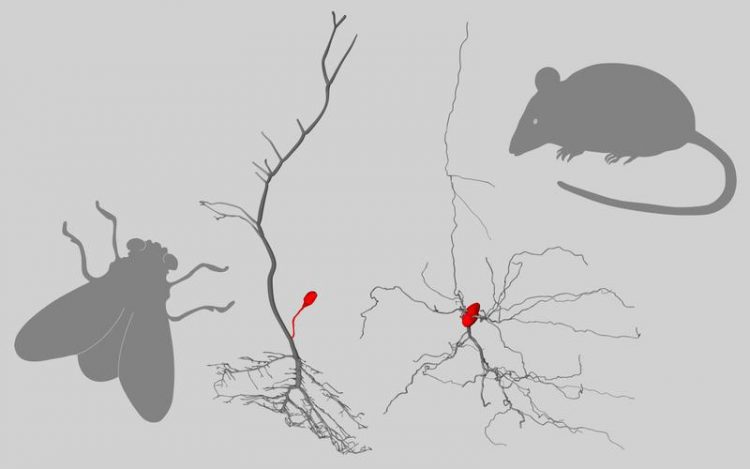Why some neurons “outsource” their cell body

Nerve cells have different shapes: while the cell body (red) is found in a central position in rat, it is located at the end of a cell prolongation in fly. Copyright: Janina Hesse, 2015
Nerve cells follow a functional design: They receive input signals over more or less ramified cell branches (dendrites), which they forward to other nerve cells along an elongated, thin cell process (axon).
The cell body contains the nucleus with genetic material and other components of the machinery that keeps the neuron alive. Its location differs significantly between animal classes: in mammals, the cell body is usually found at a central position between the dendrites and the axon, while in insects, it is often “outsourced” to the end of a separate prolongation.
“Since the description of nerve cells by Santiago Ramón y Cajal, there have been many speculations about the reasons for these different morphologies,” says first author Janina Hesse at the Bernstein Center Berlin and the Humboldt University of Berlin. “Our study now points to a crucial cause: the reduction of signal loss and energy required during the transmission of electrical signals within the nerve cell.”
To support their hypothesis, the biologists applied mathematical models to determine the benefits of the remote location of the cell body. The computer models included the essential components of a nerve cell in a simplified form. In the models, the cell body was located either in a central or in an externalized position. This way, the researchers could simulate the electrical signal transmission in both conditions and estimate the required energy and conduction losses.
“In order to transmit a signal to another cell, a neuron requires a certain signal strength in the axon. When the signal has to pass a central soma before it reaches the axon, the membrane leak diminishes the signal. This signal loss can be countered by active boosting, which is energetically costly for large cell bodies. A better solution may be an externalization of the cell body,” senior author Susanne Schreiber explains.
Hence, for organisms with large cell bodies, it is best not to make the signal pass across the cell body, but to transmit it straight from the dendrite to the axon. Insects take this direct route by relocating the neural cell bodies to the end of a thin prolongation. This advantageous shape allows the neurons to efficiently transmit even small input signals to neighboring cells. With their results, the Berlin researchers have shed light on a mystery neuroscientists have pondered since the first detailed morphological studies over 100 years ago. Their study has been published in the current issue of the journal Current Biology.
The Bernstein Center Berlin is part of the National Bernstein Network Computational Neuroscience in Germany. With this funding initiative, the German Federal Ministry of Education and Research (BMBF) has supported the new discipline of Computational Neuroscience since 2004 with over 180 million Euros. The network is named after the German physiologist Julius Bernstein (1835-1917).
Contact:
Janina Hesse
Humboldt-Universität zu Berlin
Institut für Theoretische Biologie (ITB)
Philippstr. 13, Haus 4
10115 Berlin
Tel: +49 (0)30 2093 98407
E-Mail: janina.hesse@bccn-berlin.de
Prof. Dr. Susanne Schreiber
Humboldt-Universität zu Berlin
Institut für Theoretische Biologie (ITB)
Philippstr. 13, Haus 4
10115 Berlin
Tel: +49 (0)30 2093 98405
E-Mail: s.schreiber@hu-berlin.de
Original publication:
J. Hesse & S. Schreiber (2015): Externalization of neuronal somata as an evolutionary strategy for energy economization. Current Biology, 25(8), R324 – R325.
doi: 10.1016/j.cub.2015.02.024
Free access link: http://authors.elsevier.com/a/1QurA3QW8RZuOX
Please see dispatch in the same edition:
J. E. Niven (2015): Neural Evolution: Marginal gains through soma location. Current Biology, 25(8), pR330–R332.
doi: 10.1016/j.cub.2015.02.059
http://www.neuron-science.de Website research group Schreiber
https://www.hu-berlin.de Humboldt-Universität in Berlin
https://www.bccn-berlin.de Bernstein Center Berlin
http://www.nncn.de National Bernstein Network Computational Neuroscience
Media Contact
All latest news from the category: Life Sciences and Chemistry
Articles and reports from the Life Sciences and chemistry area deal with applied and basic research into modern biology, chemistry and human medicine.
Valuable information can be found on a range of life sciences fields including bacteriology, biochemistry, bionics, bioinformatics, biophysics, biotechnology, genetics, geobotany, human biology, marine biology, microbiology, molecular biology, cellular biology, zoology, bioinorganic chemistry, microchemistry and environmental chemistry.
Newest articles

A ‘language’ for ML models to predict nanopore properties
A large number of 2D materials like graphene can have nanopores – small holes formed by missing atoms through which foreign substances can pass. The properties of these nanopores dictate many…

Clinically validated, wearable ultrasound patch
… for continuous blood pressure monitoring. A team of researchers at the University of California San Diego has developed a new and improved wearable ultrasound patch for continuous and noninvasive…

A new puzzle piece for string theory research
Dr. Ksenia Fedosova from the Cluster of Excellence Mathematics Münster, along with an international research team, has proven a conjecture in string theory that physicists had proposed regarding certain equations….



